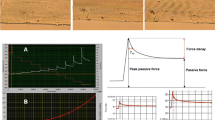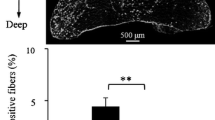Abstract
Muscles of old laboratory rodents experience exaggerated force losses after eccentric contractile activity. We extended this line of inquiry to humans and investigated the influence of fiber myosin heavy chain (MHC) isoform content on the injury process. Skinned muscle fiber segments, prepared from vastus lateralis biopsies of elderly men and women (78 ± 2 years, N = 8), were subjected to a standardized eccentric contraction (strain, 0.25 fiber length; velocity, 0.50 unloaded shortening velocity). Injury was assessed by evaluating pre- and post-eccentric peak Ca2+-activated force per fiber cross-sectional area (F max). Over 90% of the variability in post-eccentric F max could be explained by a multiple linear regression model consisting of an MHC-independent slope, where injury was directly related to pre-eccentric F max, and MHC-dependent y-intercepts, where the susceptibility to injury could be described as type IIa/IIx fibers > type IIa fibers > type I fibers. We previously reported that fiber type susceptibility to the same standardized eccentric protocol was type IIa/IIx > type IIa = type I for vastus lateralis fibers of 25-year-old adults (Choi and Widrick, Am J Physiol Cell Physiol 299:C1409–C1417, 2010). Modeling combined data sets revealed significant age by fiber type interactions, with post-eccentric F max deficits greater for type IIa and type IIa/IIx fibers from elderly vs. young subjects at constant pre-eccentric F max. We conclude that the resistance of the myofilament lattice to mechanical strain has deteriorated for type IIa and type IIa/IIx, but not for type I, vastus lateralis fibers of elderly adults.






Similar content being viewed by others
References
Aagaard P, Suetta C, Caserotti P, Magnusson SP, Kjaer M (2010) Role of the nervous system in sarcopenia and muscle atrophy with aging: strength training as a countermeasure. Scand J Med Sci Sports 20(1):49–64
Balnave CD, Allen DG (1995) Intracellular calcium and force in single mouse muscle fibres following repeated contractions with stretch. J Physiol 488(Pt 1):25–36
Belcastro AN (1993) Skeletal muscle calcium-activated neutral protease (calpain) with exercise. J Appl Physiol 74(3):1381–1386
Brooks SV, Faulkner JA (1990) Contraction-induced injury: recovery of skeletal muscles in young and old mice. Am J Physiol 258(3 Pt 1):C436–442
Brooks SV, Faulkner JA (1996) The magnitude of the initial injury induced by stretches of maximally activated muscle fibres of mice and rats increases in old age. J Physiol 497(Pt 2):573–580
Brown LM, Hill L (1991) Some observations on variations in filament overlap in tetanized muscle fibres and fibres stretched during a tetanus, detected in the electron microscope after rapid fixation. J Muscle Res Cell Motil 12(2):171–182
Childers MK, McDonald KS (2004) Regulatory light chain phosphorylation increases eccentric contraction-induced injury in skinned fast-twitch fibers. Muscle Nerve 29(2):313–317
Choi S, Widrick JJ (2010) Calcium-activated force of human muscle fibers following a standardized eccentric contraction. Am J Physiol Cell Physiol 299:C1409–C1417
Chopard A, Pons F, Marini JF (2001) Cytoskeletal protein contents before and after hindlimb suspension in a fast and slow rat skeletal muscle. Am J Physiol Regul Integr Comp Physiol 280(2):R323–330
Clarkson PM, Dedrick ME (1988) Exercise-induced muscle damage, repair, and adaptation in old and young subjects. J Gerontol 43(4):M91–96
Cutlip RG, Baker BA, Geronilla KB, Mercer RR, Kashon ML, Miller GR, Murlasits Z, Alway SE (2006) Chronic exposure to stretch-shortening contractions results in skeletal muscle adaptation in young rats and maladaptation in old rats. Applied physiology, nutrition, and metabolism = Physiologie appliquee, nutrition et metabolisme 31(5):573–587
Dedrick ME, Clarkson PM (1990) The effects of eccentric exercise on motor performance in young and older women. Eur J Appl Physiol Occup Physiol 60(3):183–186
Delbono O, O’Rourke KS, Ettinger WH (1995) Excitation-calcium release uncoupling in aged single human skeletal muscle fibers. J Membr Biol 148(3):211–222
Fabiato A (1988) Computer programs for calculating total from specified free or free from specified total ionic concentrations in aqueous solutions containing multiple metals and ligands. Methods Enzymol 157:378–417
Fielding RA, Meydani M (1997) Exercise, free radical generation, and aging. Aging (Milano) 9(1–2):12–18
Frontera WR, Suh D, Krivickas LS, Hughes VA, Goldstein R, Roubenoff R (2000) Skeletal muscle fiber quality in older men and women. Am J Physiol Cell Physiol 279(3):C611–618
Gannon J, Staunton L, O’Connell K, Doran P, Ohlendieck K (2008) Phosphoproteomic analysis of aged skeletal muscle. Int J Mol Med 22(1):33–42
Goodpaster BH, Park SW, Harris TB, Kritchevsky SB, Nevitt M, Schwartz AV, Simonsick EM, Tylavsky FA, Visser M, Newman AB (2006) The loss of skeletal muscle strength, mass, and quality in older adults: the health, aging and body composition study. J Gerontol A Biol Sci Med Sci 61(10):1059–1064
Hardin J, Carroll R (2003) Variance estimation for the instrumental variables approach to measurement error in generalized linear models. Stata Journal 3(4):342–350
Hook P, Sriramoju V, Larsson L (2001) Effects of aging on actin sliding speed on myosin from single skeletal muscle cells of mice, rats, and humans. Am J Physiol Cell Physiol 280(4):C782–788
Hortobagyi T, Zheng D, Weidner M, Lambert NJ, Westbrook S, Houmard JA (1995) The influence of aging on muscle strength and muscle fiber characteristics with special reference to eccentric strength. J Gerontol A Biol Sci Med Sci 50(6):B399–406
Ingalls CP, Warren GL, Williams JH, Ward CW, Armstrong RB (1998) E-C coupling failure in mouse EDL muscle after in vivo eccentric contractions. J Appl Physiol 85(1):58–67
Kawai M, Wray JS, Zhao Y (1993) The effect of lattice spacing change on cross-bridge kinetics in chemically skinned rabbit psoas muscle fibers. I. Proportionality between the lattice spacing and the fiber width. Biophys J 64(1):187–196
Klass M, Baudry S, Duchateau J (2007) Voluntary activation during maximal contraction with advancing age: a brief review. Eur J Appl Physiol 100(5):543–551
Koh TJ, Escobedo J (2004) Cytoskeletal disruption and small heat shock protein translocation immediately after lengthening contractions. Am J Physiol Cell Physiol 286(3):C713–722
Krivickas LS, Suh D, Wilkins J, Hughes VA, Roubenoff R, Frontera WR (2001) Age- and gender-related differences in maximum shortening velocity of skeletal muscle fibers. Am J Phys Med Rehabil 80(6):447–455, quiz 456–447
Larsson L, Grimby G, Karlsson J (1979) Muscle strength and speed of movement in relation to age and muscle morphology. J Appl Physiol 46(3):451–456
Larsson L, Li X, Frontera WR (1997) Effects of aging on shortening velocity and myosin isoform composition in single human skeletal muscle cells. Am J Physiol 272(2 Pt 1):C638–649
Lavender AP, Nosaka K (2006a) Comparison between old and young men for changes in makers of muscle damage following voluntary eccentric exercise of the elbow flexors. Appl Physiol Nutr Metab 31(3):218–225
Lavender AP, Nosaka K (2006b) Responses of old men to repeated bouts of eccentric exercise of the elbow flexors in comparison with young men. Eur J Appl Physiol 97(5):619–626
Lehti TM, Kalliokoski R, Komulainen J (2007) Repeated bout effect on the cytoskeletal proteins titin, desmin, and dystrophin in rat skeletal muscle. J Muscle Res Cell Motil 28(1):39–47
Lexell J, Taylor CC, Sjostrom M (1988) What is the cause of the ageing atrophy? Total number, size and proportion of different fiber types studied in whole vastus lateralis muscle from 15- to 83-year-old men. J Neurol Sci 84(2–3):275–294
Lieber RL, Thornell LE, Friden J (1996) Muscle cytoskeletal disruption occurs within the first 15 min of cyclic eccentric contraction. J Appl Physiol 80(1):278–284
Lovering RM, De Deyne PG (2004) Contractile function, sarcolemma integrity, and the loss of dystrophin after skeletal muscle eccentric contraction-induced injury. Am J Physiol Cell Physiol 286(2):C230–238
Lowe DA, Surek JT, Thomas DD, Thompson LV (2001) Electron paramagnetic resonance reveals age-related myosin structural changes in rat skeletal muscle fibers. Am J Physiol Cell Physiol 280(3):C540–547
Lynch GS, Faulkner JA, Brooks SV (2008) Force deficits and breakage rates after single lengthening contractions of single fast fibers from unconditioned and conditioned muscles of young and old rats. Am J Physiol Cell Physiol 295(1):C249–256
Macpherson PC, Schork MA, Faulkner JA (1996) Contraction-induced injury to single fiber segments from fast and slow muscles of rats by single stretches. Am J Physiol 271(5 Pt 1):C1438–1446
Manfredi TG, Fielding RA, O’Reilly KP, Meredith CN, Lee HY, Evans WJ (1991) Plasma creatine kinase activity and exercise-induced muscle damage in older men. Med Sci Sports Exerc 23(9):1028–1034
McBride TA, Gorin FA, Carlsen RC (1995) Prolonged recovery and reduced adaptation in aged rat muscle following eccentric exercise. Mech Ageing Dev 83(3):185–200
Meyer GA, Kiss B, Ward SR, Morgan DL, Kellermayer MS, Lieber RL (2010) Theoretical predictions of the effects of force transmission by desmin on intersarcomere dynamics. Biophys J 98(2):258–266
Morgan DL (1990) New insights into the behavior of muscle during active lengthening. Biophys J 57(2):209–221
Ochala J, Dorer DJ, Frontera WR, Krivickas LS (2006) Single skeletal muscle fiber behavior after a quick stretch in young and older men: a possible explanation of the relative preservation of eccentric force in old age. Pflugers Arch 452(4):464–470
Phillips SK, Bruce SA, Woledge RC (1991) In mice, the muscle weakness due to age is absent during stretching. J Physiol 437:63–70
Porter MM, Vandervoort AA, Kramer JF (1997) Eccentric peak torque of the plantar and dorsiflexors is maintained in older women. J Gerontol A Biol Sci Med Sci 52(2):B125–131
Poulin MJ, Vandervoort AA, Paterson DH, Kramer JF, Cunningham DA (1992) Eccentric and concentric torques of knee and elbow extension in young and older men. Can J Sport Sci 17(1):3–7
Prado LG, Makarenko I, Andresen C, Kruger M, Opitz CA, Linke WA (2005) Isoform diversity of giant proteins in relation to passive and active contractile properties of rabbit skeletal muscles. J Gen Physiol 126(5):461–480
Proske U, Morgan DL (2001) Muscle damage from eccentric exercise: mechanism, mechanical signs, adaptation and clinical applications. J Physiol 537(Pt 2):333–345
Rader EP, Faulkner JA (2006) Effect of aging on the recovery following contraction-induced injury in muscles of female mice. J Appl Physiol 101(3):887–892
Sato T, Akatsuka H, Kito K, Tokoro Y, Tauchi H, Kato K (1984) Age changes in size and number of muscle fibers in human minor pectoral muscle. Mech Ageing Dev 28(1):99–109
Schiaffino S, Reggiani C (1996) Molecular diversity of myofibrillar proteins: gene regulation and functional significance. Physiol Rev 76(2):371–423
Thompson LV, Brown M (1999) Age-related changes in contractile properties of single skeletal fibers from the soleus muscle. J Appl Physiol 86(3):881–886
Vijayan K, Thompson JL, Riley DA (1998) Sarcomere lesion damage occurs mainly in slow fibers of reloaded rat adductor longus muscles. J Appl Physiol 85(3):1017–1023
Vijayan K, Thompson JL, Norenberg KM, Fitts RH, Riley DA (2001) Fiber-type susceptibility to eccentric contraction-induced damage of hindlimb-unloaded rat AL muscles. J Appl Physiol 90(3):770–776
Wang ZM, Messi ML, Delbono O (2002) Sustained overexpression of IGF-1 prevents age-dependent decrease in charge movement and intracellular Ca(2+) in mouse skeletal muscle. Biophys J 82(3):1338–1344
Warren GL, Lowe DA, Hayes DA, Karwoski CJ, Prior BM, Armstrong RB (1993) Excitation failure in eccentric contraction-induced injury of mouse soleus muscle. J Physiol 468:487–499
Warren GL, Hayes DA, Lowe DA, Williams JH, Armstrong RB (1994) Eccentric contraction-induced injury in normal and hindlimb-suspended mouse soleus and EDL muscles. J Appl Physiol 77(3):1421–1430
Zerba E, Komorowski TE, Faulkner JA (1990) Free radical injury to skeletal muscles of young, adult, and old mice. Am J Physiol 258(3 Pt 1):C429–435
Zhang BT, Yeung SS, Allen DG, Qin L, Yeung EW (2008) Role of the calcium–calpain pathway in cytoskeletal damage after eccentric contractions. J Appl Physiol 105(1):352–357
Acknowledgments
This research was supported by NIA R01-AG-18844 to RA Fielding, the Boston Claude D. Pepper Older Americans Independence Center (1P30AG031679) and by the U.S. Department of Agriculture, under agreement no. 58-1950-7-707. Any opinions, findings, conclusion, or recommendations expressed in this publication are those of the author(s) and do not necessarily reflect the view of the U.S. Department of Agriculture.
Author information
Authors and Affiliations
Corresponding author
About this article
Cite this article
Choi, S.J., Lim, JY., Nibaldi, E.G. et al. Eccentric contraction-induced injury to type I, IIa, and IIa/IIx muscle fibers of elderly adults. AGE 34, 215–226 (2012). https://doi.org/10.1007/s11357-011-9228-2
Received:
Accepted:
Published:
Issue Date:
DOI: https://doi.org/10.1007/s11357-011-9228-2




